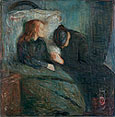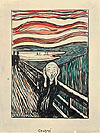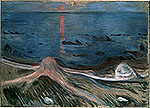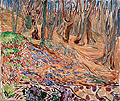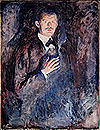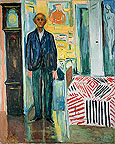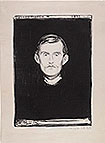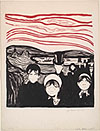The browser will either open the file, download it, or display a dialog.
|
Edvard Munch: The Modern Life of the Soul
Edvard Munch: Symbolism in Print
Edvard Munch: The Modern Life of the Soul |
||||||
| Edvard Munch: The Modern Life of the Soul was the first retrospective of Munch (1863-1944) to appear in an American museum in almost thirty years. Including 87 paintings and 50 works on paper, it surveyed the Norwegian artist's work from 1880 to 1944. While the exhibition itself presented a crowd-pleasing array of paintings, the accompanying catalogue contributes a significant new scholarly reference on Munch. It includes concise essays by leading American Munch experts Patricia Berman, Reinhold Heller, Elizabeth Prelinger, and Tina Yarborough that refreshingly challenge some of our most basic assumptions about Munch and expressionism. It also contains excellent color plates, a rich chronology, exhibition history, selected bibliography, and brief but valuable notes on each plate. The small installation at Scandinavia House of 25 prints from the Museum of Modern Art's collection, curated by Deborah Wye, chief curator of Prints and Illustrated Books at MoMA, presented a welcome balance for the larger show, which neglected works on paper. It focused in depth on a smaller set of Munch's best-known 1890s motifs, emphasizing the artist's unprecedented experiments with woodcut, linocut, lithograph, etching and aquatint through effective comparisons of the same motif in divergent processes. Together, the shows raised significant issues regarding the reception of Munch as a modernist "master," revealing new aspects of his work and providing an opportunity to re-evaluate our assumptions about originality versus social context in Munch's oeuvre. | ||||||
| The exhibition in the recently expanded Museum of Modern Art, which opened its exceptionally spacious neo-modernist galleries designed by Yoshio Taniguchi in November 2004, was by many accounts a blockbuster. Well prepared by the press for the absence of the beloved Scream in oil, visitors thronged to see what was routinely lauded as a "beautiful" installation of the symbolist-expressionist artist's work.1 They were rewarded with a spectacular presentation by chief curator-at-large, Kynaston McShine, focusing on large paintings rather than the nearly 30,000 extant prints and hundreds of photographs taken by Munch over the years. The installation laudably emphasized the understudied late work, including several surprisingly contemporary but rarely seen portraits and landscapes. The order of its installation left much to be desired, however, mixing early and late works in many instances and often separating sketches from paintings, paint from print media, in a layout that may well have confused the average viewer rather than presenting a coherent historical picture. Kynaston McShine's introductory essay praises Munch unequivocally for the transformation "through his own will and force" (11) of his personal experiences into iconic works of art; by submitting to the temptation offered by Munch's own intensely introspective writings, McShine separates the artist's private history completely from its social context. Such an approach and installation distinctly appeals to the public's existing level of knowledge about, and interest in, art history, which focuses on the vicarious pleasure of witnessing the painterly evidence of so-called genius without attempting to question received ideas. Fortunately, the catalog's scholarly contributions balance this perspective. Overall, the exhibition presented a fascinating, albeit predictably conservative, opportunity to study both familiar and unexpected works. It was accompanied by a series of enlightening presentations and debates at the Museum of Modern Art and Scandinavia House that satisfied a distinct segment of the public that is passionate about Munch and eager for fresh approaches to an artist beloved for his experimental and captivating images of emotional drama. | ||||||
| Other major Munch exhibitions, most notably at the Albertina in Vienna in 2003 and at the National Gallery in Washington in 1978, have approached Munch's work thematically, supported by Munch's own tendency to rework images throughout his life and organize them as part of life cycle series.2 The most famous series was the "Frieze of Life," the organizing principle by which Munch began exhibiting his works in 1893, first shown as a retrospective group at the Berlin Secession in 1902 and featuring such subheadings as "The Flowering and Passing of Love," "Anxiety," and "Death." The thematic approach to exhibiting Munch's work also sidesteps the problem of chronology for an oeuvre, the vast majority of which was undated and consists of motifs repeated over a fifty-year period, which presents a major problem for the paintings catalogue raisonné project currently under the supervision of Gerd Woll, director of the Munch Museum in Oslo.3 There are distinct intellectual advantages of a thematic show as well, because it can lead to significant contextualization and interdisciplinary scholarship such as that exemplified in the catalogues of the Albertina and the National Gallery shows, both of which were large scale and innovative exhibitions which produced somewhat more substantial scholarly contributions than the MoMA show. | ||||||
|
A chronological exhibition will always satisfy the historian as well as the public, however, and it remains a favored tradition at the Museum of Modern Art. The linear chronology of the MoMA exhibition progressed from the first gallery, showcasing (for the most part) the 1880s and early 1890s, to an adjacent large space which was sub-divided into four smaller rooms, as was the final section, focusing on the 1890s; the exhibition concluded with another large, square four-part gallery comprising Munch's final four decades. The first room highlighted the range of styles attempted by Munch in the 1880s, from the Nordic naturalism inspired by his teacher, Christian Krohg, to the matte surfaces referencing Puvis de Chavannes, seen on an early visit to Paris in 1885, to Impressionism based on Pissarro or Caillebotte and Symbolism in the art nouveau manner of Toulouse-Lautrec. The chronological approach does well to underscore the coexistence of radically different stylistic experiments within a year or two of each other, for example in the relatively smooth curvilinear shapes and bold colors of The Inheritance I of 1897-99, shown next to the dissolving forms and deeply-gauged striations of The Sick Child (fig. 1), both shown in the second section. This version of the Sick Child from 1896 stood in for the original 1886 composition; its heavily worked over, scratched and gouged surface, which Munch painted as a deliberately close imitation of the earlier work, is equally compelling as the earlier version of this breakthrough piece, and provides the first of many examples of Munch's incessant returns to key subjects throughout his career. | |||||
| The exhibition was reasonably comprehensive despite its well-publicized omission of the four oil-on-cardboard paintings of The Scream, one of which was stolen from the Munch Museum in 2004 and remains missing. The painting was replaced by the three major paintings, Evening on Karl Johan Street (1892), Despair (1892) (fig. 2), and Angst (1894), with their related motifs of the crowd scene and the charged setting of the road from Kristiania to Ekeberg,4 which greeted the viewer upon entering the second major section of the exhibition, devoted to the 1890s. The Despair introduced the initial Scream composition with Munch's schematic and featureless profile against the railing, highlighting the radical departure of the small humanoid figure in the final version of the Scream. This famous figure was not shown next to Despair, however, but placed in the darkened prints section at the opposite end of this section, where most casual viewers missed it. There, The Scream appeared in two lithographs (fig. 3), as well as in the original drawing of the composition accompanied by Munch's descriptive prose poem. Another less than coherent sequence was the presentation of key paintings: Madonna (oil on canvas from 1894–95, another version of which was stolen along with The Scream) (fig. 4), Ashes (1894), and Vampire (1893–94) on a wall facing a room divider while prime real estate in the exhibition went to random groupings. One of these was the pairing of the intriguing Mystery of the Beach (1892) (fig. 5) with the unrelated sketch for The Voice/Summer Night (1893), both of which were installed across from the dissimilar architectural ornament of The Mermaid (1896). This rather hackneyed version of the Nordic icon was interesting to see framed by the triangular wood rafters of its original setting but less than illuminating placed randomly in the midst of Munch's tormented 1890s "Frieze of Life" imagery around the edges of the room. | ||||||
| The final section of Munch's late work was in some ways the most coherent and illuminating of the MoMA exhibition. The installation presented a satisfying threshold between the 1890s area and the last section, a large light-filled space opening with Munch's vitalist mural sketch, The Sun (1912), accompanied by the female outdoor bathers of Nude Figures and Sun (1910–19). In this period, following his yearlong recovery from alcoholism in a Danish sanatorium, Munch took a new interest in the healthy body, bolstered by vitalist and monist ideas drawn from philosophers like Friedrich Nietzsche and Ernst Haeckel.5 In line with the development in contemporary philosophy of ontologies based on energy rather than matter, Munch's post-1900 bathers appear animated by a life force emanating directly from the sun. Distinctly opposed to the dealthy pale and ethereal nudes of his 1890s work, they also reflect the painter's participation in the turn-of-the-century rage for bathing in the open air as a health cure.6 The intensely colorful works, including several landscapes inspired by French avant-garde painting (fig. 6) encouraged viewers, perhaps a bit staggered by the unremitting emotional intensity of Munch's pre-1900 world of anxiety, illness, and death, to enter the less familiar and less stereotypically expressionist (but equally expressive) late period. The monumental 1907 Bathing Men and the images of Munch's maid, Ingeborg Kaurin, in particular Model by the Wicker Chair I (1919–21), presented Munch's radical new world of intense color complements and emphasis on robust and powerful bodies, male and female. The exhibition highlighted the deliberate naturalism of Munch's portraits of his patrons' children alongside the intensely colorful, Nietzschean vitality of his male portraits, including a large scale charcoal, pastel, and tempera drawing for the oil portrait commissioned in 1906 of the philosopher himself. | ||||||
| I found the images of Sultan Abdul Karim in The Slave (1916–17) and Black Man Wearing Green Striped Scarf (1916–17), apparently shown for the first time in a Munch retrospective, fascinating considering the rarity of images of African people in European art of this period as anything but savages. In the former image, Munch depicts Karim, a circus performer traveling through Oslo at the time, in what seems at first glance a clichéd image of a nineteenth century orientalist theme: a nude black slave paired with a dressed Cleopatra as modeled by Munch's housekeeper Helga Rogstad. Yet the pairing is a decidedly theatrical and modern version of the old theme, isolating the two distinctly introspective and inscrutable figures each on a separate panel. The two are connected only by the woman's gaze at the man's body, colored lushly in rainbow hues and brown tones equivalent to the rainbow and pastel tones of Model by a Wicker Chair. The scene in fact reverses the usual orientalist depictions of harem women arranged for male delectation with a woman coolly contemplating (as opposed to coveting) a robust non-white man, himself far less sexualized than the virile white Bathers of 1907. The Black Man Wearing Green Striped Scarf shown next to it presents a portrait sketch of Karim with a strikingly distinguished air. Such later images both powerfully challenge the received view of Munch as a tormented expressionist and register his own unique contributions, however small, to the politically charged discourse of orientalism. It contributed new insight into Munch's late work, on display in the final section. | ||||||
| Given the exhibition's general chronological organization, however, it was striking and at times puzzling how often that chronology (to the extent that the works are securely dated) was violated to little apparent advantage. In the first room, for example, next to the key early painting The Day After, a Kristiania bohème scene repainted in 1894 after a lost original of 1886, appeared portraits of Munch's Berlin-era colleagues Dagny Juel Przybyszewska (1893) and art critic Julius Meier-Graefe (c. 1895) followed by the decidedly more naturalistic late afternoon café setting of Hans Jaeger (1889) done before Munch left Kristiania, and then Ibsen in the Grand Café (1898) painted ten years later, when Munch had returned briefly to his homeland. This sequence of unrelated portraits exemplifies the exhibition's repeated grouping of genres together with complete disregard to the exhibition's own chronology. The catalogue layout reinforces this practice. There, the excellent color reproductions seem to be arranged in a similarly unfortunate compromise between thematic and chronological sequence, requiring that the reader frequently consult the index to find images. The Day After, although done at the same time and with a striking resemblance to the female figure of Dagny Juel portrayed in the Madonna of 1894-95 (fig. 4), appeared in the first room, removed from the Madonna in the second.7 | ||||||
| The most notable and deliberate break with chronology was the sequence of self-portraits ranging from 1895 to 1942 grouped together in the final subsection of the last room. Curator McShine seems to have intentionally disrupted the succession of intensely colorful late works here in order to present an interesting but at the same time jarringly synthetic sequence of Munch's personal and stylistic transformations. These self-portraits moved from fiercely decadent dandy emerging from the smoky chaos of Self-Portrait with Cigarette of 1895 (fig. 7) to victim menaced by ghoul-like masked doctors in the much more gestural and colorful On the Operating Table (1902-3), to Self-Portrait in Hell (1903), where Munch radically isolates his own torch-like figure with its looming shadow against a reddish background developed in large, flat brushstrokes that display the experimental patterning of the post-1900 work. The self-portrait sequence and the exhibition as a whole closed with the gaunt and defiant specter of Self-Portrait: Between the Clock and the Bed (1940-42) (fig. 8), the culmination of the intense colors, gestural contours, and much greater attention to surface of Munch's twentieth century work. This stylistic divergence from the approach seen in Self-Portrait with Cigarette nearby was developed over several intervening decades of Fauvism and German Expressionism, and Munch's long years of relative isolation distinctly opposed to his earlier immersion in international bohemian circles, not to mention his own distinctly healthier lifestyle since his stay in the Danish sanatorium of 1908–9. The Self-Portrait with Cigarette is closest stylistically to the portraits of Dagny Juel Przybyszewska and Julius Maier-Graefe seen in the first room of the exhibition, and would have been shown to greater advantage next to those.8 | ||||||
| The revelation of the self-portraits was less the view of these paintings together—a juxtaposition which by many accounts contributed little to their distinctive powers—than individual gems like the diminutive pastel entitled Sphinx: Androgynous Self-Portrait of c. 1909. The image combines Munch's identifiable features with long wavy hair and two adamantly round breasts. It presents a strikingly contemporary investigation of the hermaphroditic aspects of the human psyche and a fascinating counterpoint to Munch's much more well known, and decisively gendered, images of Madonna and the violinist Eva Mudocci which feature the same wavy flood of hair. The Munch catalogue also includes a larger and more vividly colored Androgynous Self-Portrait, oil on canvas, of 1927, a picture which was exhibited previously as "Sphinx."9 The larger Androgynous Self-Portrait was not in the exhibition, but is one of many additional reproductions, also including the missing Scream, in oil on cardboard, which contribute to the historiographic value of the catalogue. Little has been written about Munch's androgynous self-examinations, probably in part because they have not been labeled as such or seen until now. Such an analysis would call into question many of our received ideas about Munch's tormented relationship to women, which has frequently been mischaracterized as misogynistic. In fact, Patricia Berman has investigated the crucial and understudied (in relation to Munch) social context of popular interest in androgyny and new sexual roles of the 1890s in several enlightening texts.10 The lithograph The Brooch: Eva Mudocci (1903) would have been illuminating in direct comparison to the Sphinx: Androgynous Self-Portrait, but was relegated to an area devoted to prints and drawings on the other side of the wall. There at least it could be viewed in relation to the equally fascinating and related drawing Self-Portrait: Salomé Paraphrase (1894–98).11 The Salomé Paraphrase was another highlight of the exhibition. In drawing it, Munch rejected the dominant trend in both salon and avant-garde painting of the symbolist period for images of the exotic and invariably scantily clad dancing woman, and exercised instead a radical metonymy, depicting the temptress as nothing but a few fingerlike tendrils of hair looming ghostlike over his own disembodied head posing as John the Baptist. The male artist thus presents himself as victim to a phantom androgynous presence that may be nothing more than a figment of his own imagination, in a portrayal of tensions surrounding gender that is more evocative and complex than the standard Salomé fare of artists like Gustave Moreau or Gustav Klimt. This complex of subjects in Munch's oeuvre calls into question the very boundaries of gendered identity that were so fluid and psychologically fraught in this period, but which his work is often mistakenly understood as consolidating. | ||||||
| For conservation purposes, the MoMA installation isolated, and thus regrettably marginalized, prints and drawings in two distinct areas of the exhibition. The dim room with smaller works on paper, isolated in the back gallery of the 1890s section, presented several gems, such as the Self-Portrait with Skeleton Arm (1895) (fig. 9), further versions of Madonna, The Sick Child, and other key works. A couple of 1910s works cropped up out of chronology here, including a fascinating 1915 lithograph of The Dance of Death featuring Munch in death's embrace instead of the more well known and clichéd Death and the Maiden, which did not appear.12 This room also included the only images in the show of Towards the Forest (a stunning hand-colored woodcut of 1897), and key "Frieze of Life" motifs Jealousy and The Lonely Ones. The latter two were rare instances where multiple versions in different media shown together conveyed a sense of the singularity and range of Munch's experiments on paper. All the prints would have fared better if they had been integrated into the sequence of paintings. As Klaus Albrecht Schröder observes in the Albertina catalogue, insight into Munch's work "cannot be accomplished by placing the works on paper under quarantine in the interest of preserving the history of the collection and thus cutting them off from dialogue with the other media for which they served as preparation or to which they respond as variations."13 There were a few notable exceptions to this isolation of prints, such as the self-portraits included with paintings in their own section and the woodcut The Kiss III (1898), exhibited in juxtaposition with two earlier paintings of The Kiss from 1892 and 1897. This sequence demonstrated the transformation from the earlier interior scene of illicit passion between two people, reminiscent of impressionism due to the small figures visible on the sunlit street outside the window, to a starkly evocative fusion of two figures into one, utterly isolated from the social world. In the print, the faces and the bodies meld into amorphous shapes against a background comprising only the vertical wood grain, creating a powerful visual impact that amplifies the complex emotions—dizziness, ecstasy, terror—circulating in the embrace. | ||||||
| The Scandinavia House installation of prints was a crucial complement to the MoMA show, for its numerous pairings contributed a deeper appreciation of the artist's radical experimentation in printmaking (figs. 10–11). It was Gauguin and Munch, after all, who revived the woodcut as an avant-garde medium in late nineteenth century art, and Munch's inventive printmaking methods have influenced generations of artists. Elizabeth Prelinger surveys Munch's contributions to printmaking in the context of its widespread revival in the 1890s in her MoMA catalogue essay, "Metal, Stone, and Wood: Matrices of Meaning in Munch's Graphic Work." She provides a much needed discussion of the specifics of Munch's various techniques. As an installation, though, the Scandinavia House exhibition was much more coherent (facilitated by the intimacy of the three small exhibition rooms). It opened with Munch's first woodcut, an 1896 image of Angst in which he violently disfigured the bourgeois faces with vertical cuts of the buren. While a starker all-black print of Angst from the same woodblock appeared in the MoMA show, the Scandinavia House version was printed in vivid red with a swath of bright white marking the undulating clouds painted so blood red in The Scream. This Angst was shown next to an 1896 lithograph of the same theme (fig. 12) in which the bridge was subsumed into the background, the figures' faces shown as smoothly defined masks, and the black and white areas strikingly reversed. Other highlights at Scandinavia House included the four versions of the Sick Child in various sizes and compositions, exceptional versions of Vampire (1895–1902) and Melancholy III (1902), the latter woodcut enlivened by glowing cobalt gouache additions, and the memorable woodcut Encounter in Space (1898–99) depicting two floating lovers in intense orange and green isolated on a cosmic background of swimming spermatozoa. The show enabled viewers to see the variety of print processes and better understand the radical nature of, for example, Munch's original use of the jigsaw to create flat shapes separated by white outlines to further isolate his tormented lovers, as in Encounter in Space. Since relatively few visitors made it to Scandinavia House, it is unfortunate that the MoMA installation did not try harder to underscore the importance of the prints and drawings. Works on paper took second stage to the more spectacular paintings, even though Munch's paintings are in many cases less powerful and complex than the prints. | ||||||
| The largest omission of the show, however, and by no means one unique to MoMA, was photography. True, the exhibition opened with four enlarged reproductions of Munch's self-portrait photographs. These included an image of him painting Bathing Men on the beach, and a photograph of an elder Munch painting in his snow-filled outdoor studio at Ekely, demonstrating both his avant-garde disregard for the works as valuable or fragile objects as well as his intriguing fetishization of them as personal "guardians" standing directly on the earth.14 Yet not only did Munch use photography to aid composition as regularly as any self-respecting late nineteenth century naturalist or Impressionist artist since his earliest training in Norway, but he also experimented radically with photography after acquiring a camera in 1902.15 Given the drastic expansion of photographic reproduction in print media in the late 19th-Century in general, and Munch's specific use of photography from city scenes to snapshots to cartes de visite, why persist in treating it as a mere document? Munch's interest in X-ray and other scientific photography, his friendship with August Strindberg who created notable photographic experiments himself, and our current understanding of photography as one of the key sites of innovation in modern art—as demonstrated in numerous photo exhibitions at MoMA—are further reasons that an exploration of the photographs as artworks is long overdue. Clearly, the exhibition was deeply invested in the primacy of painting as an expressive medium, and the myth of Munch as an utterly original expressionist master which would be tarnished not only by a more in-depth exposition of historical and social context, but especially by the notion of him either copying a gesture from a photograph or producing an original composition in the medium of photography, given its radically different origins, functions, and mechanical apparatus. Munch's photographic self-portraits and the films he made at Ekely in 1927 depict him in unusual angles and croppings, double exposures, and shadowy transparency in front of his pictures; these scenes evoke all kinds of fleeting glimpses and subjective moods as expressive and eloquent as his painting. They demand further investigation, and treatment as specific aesthetic objects rather than simple reproductions to be used as illustrations of Munch's life. Like many previous retrospectives including those at the National Gallery and the Albertina, the Museum of Modern Art merely continued this long-standing trend of omission. | ||||||
| The catalogue, despite maintaining the use of photography as mere illustration,16 presents not only a significant reevaluation of the artist, but also a rich array of excellent color reproductions, individual notes on the works in the exhibition, and detailed information on Munch's chronology and exhibition history. The essays analyze various aspects of Munch's oeuvre, with mostly enlightening results. Reinhold Heller admirably attempts to drive a wedge between the all too easy assumption that Munch's Scream was a direct and unmediated illustration of his personal experience (as Munch himself asserted). Heller points out that the text accompanying The Scream was not a diary entry, but a prose poem written after Munch had left Kristiania, the structure of which related explicitly to literary conventions of the time.17 He also argues, significantly, that the anxiety depicted in Munch's Scream stemmed less from his own experience on the bridge than from the overall inadequacy of what Munch called the "miserable means available to painting" to depict inner emotion (23). His point is well taken, if argued a bit simplistically. Why attempt, for example, to identify one specific "despair Munch then experienced" (24) when the significance of the work is precisely its constant availability to new readings? Moreover, Heller's sophisticated understanding of the literary context does not lead to an equally developed art historical analysis. He misses a prime opportunity to explore the likely visual sources for the homunculus figure in The Scream. The figure is likely based on the same Incan mummy of a woman buried in a fetal position known to be a visual inspiration for Gauguin in such iconic paintings as Where Do We Come From? What Are We? Where Are We Going? (Museum of Fine Arts, Boston, 1897–98). The mummy was the basis for the crone at far left.18 Gauguin's work left a distinct impression on Munch, as seen in his emphasis on painterly contours, absolute rejection of spatial recession, and use of such similar subjects as depicting himself as Christ on the cross in Golgotha (1900), in the MoMA exhibition. Moreover, Munch moved to Paris in 1889 and it seems unlikely that he would have missed the massively publicized Colonial Exposition where Gauguin saw the mummy, since it ran until November 6th of that year. Robert Rosenblum first suggested the possibility of the mummy as a source for The Scream in the 1970s,19 and although his assertion has inexplicably never been further investigated by art historians, the striking similarity of the staring mummy with her hands on either side of her head to Munch's radically altered figure speaks volumes. Heller writes that the screaming figure suggests that Munch internalized certain anti-naturalist tendencies in the art of the insane, which he may have seen at the time in Berlin (27), but Heller's failure to analyze or even suggest any specific visual sources makes the suggestion meaningless, if not over determined. Rather than extricate the visual source of the mummy, Heller asserts instead: "The Scream embodies a degree of originality and uniqueness seldom seen in the history of modern art" (26). He thus contributes, most likely despite his own intentions, another chapter to the Munch myth.20 | ||||||
| Patricia Berman's essay, "Edvard Munch's ‘Modern Life of the Soul,'" more successfully illuminates one of the central issues in Symbolist studies: the relationship of the erotic and the spiritual. She examines Munch's use of the phrase "modern life of the soul" to describe his "Frieze of Life" series not as a rejection of spirituality completely, but as a denunciation of organized Christian spirituality in favor of a modern understanding of individual imagination as transcendent, and the soul as a temporal force defined by its historical age. Berman cites a broad set of literary and philosophical reference points to contextualize Munch's understanding of the "soul" in the writings of contemporaries like Knut Hamsun, Sigbjørn Obstfelder, Ernst Haeckel, Strindberg, and Przybyszewski. She briefly describes Munch's understanding of the city as a site of social instability and anxiety in relationship to contemporary analyses such as those of Georg Simmel (42), and his reinterpretations of Christian sacred imagery in relation to contemporary artists like Gauguin and Ensor (44–45). Her contextualization contributes to the critical understanding of Munch as working—and thinking and feeling—in a social milieu, against which he enacted his own "biography as performance" (46). | ||||||
| Following Elizabeth Prelinger's discussion of Munch's prints, Tina Yarborough closes the catalogue with her essay "Public Confrontations and Shifting Allegiances: Edvard Munch and the Art of Exhibition." Yarborough further amends the distortions of the Munch myth by examining his activities as a market-conscious organizer of his own retrospective exhibitions. She describes how Munch consciously transformed his image through his choice of topics and exhibition designs around the time of World War I from a Germanic artist of angst into an ally of the younger Norwegian students of Matisse known as "the 14." Although it would have benefited by specific visual comparisons with the work of these younger artists as well as Paul Cézanne, whom she discusses, and Ferdinand Hodler, whom she does not,21 her account illuminates a less well-known aspect of Munch's self-fashioning. Examining Munch's role in self-promotion and his later reception in Norway, it inherently contributes a greater understanding of the artist's active participation in a social world. Like the essays by Heller and Berman, it provides a richer understanding of Munch. Rather than view him as a simple expressionist, on the one hand tormented by the nightmarish visions that at a certain moments somehow externalized themselves in his artwork, and on the other, utterly original in his spontaneous development of unprecedented motifs, these essays dislodge those clichés with a more complex image of the artist as a conscious agent who consistently regarded his own self-representation as a means to break away from inherited modes of seeing, understanding, and relating to the social world. Although the catalogue essays are brief, they contribute overall a necessary corrective (if one for the most part overlooked by exhibition viewers) to the overwhelming tendency to heroicize Munch-the-genius-painter in the installation, which essentially served up a MoMA-fied Munch. | ||||||
|
Karen Kurczynski |
||||||
|
1. The crowds even inspired one author's suggestion regarding the depleted woman in The Day After (1894) that, "Perhaps she, too, had been to an art museum over the weekend." Ira Berkow, "Sometimes, Viewing Art Involves Breaking a Full-Court Press," The New York Times, Wednesday, March 29, 2006, G2. 2. Robert Rosenblum, ed., Edvard Munch: Symbols and Images, exh. cat. (Washington: National Gallery of Art, 1978); Klaus Albrecht Schröder and Antonia Hoerschelmann, eds., Edvard Munch: Theme and Variation, exh. cat. (Vienna: Albertina, 2003). 3. Woll discussed the paintings project in a presentation at the symposium "Munch Today" at Scandinavia House on February 15, 2006. She previously authored the catalogue raisonné of Munch's prints: Edvard Munch: The Complete Graphic Works (New York: Abrams; Munch-Museet, Oslo, 2001). 4. For details on the setting of Despair, Angst, and The Scream, see Sue Prideaux, Edvard Munch: Behind the Scream (New Haven: Yale University Press, 2005), 151. 5. On the development of vitalism in philosophy, see Frederick Burwick and Paul Douglass, eds., The Crisis in Modernism: Bergson and the Vitalist Controversy (New York: Cambridge University Press, 1992). On Munch's relation to monism, see Berman's MoMA catalog essay, 40–41. 6. For a discussion of male bathers as images of health in Munch's late work, see Patricia Berman, "Monumentality and historicism in Edvard Munch's University of Olso festival hall paintings," Ph.D. dissertation, New York University, 1989. 7. Museum visitors remarked upon this and other disjunctions to me during public tours of the exhibition. 8. In her recent biography of Munch, Prideaux even asserts that the Self-Portrait with Cigarette and the Portrait of Dagny Juel Przybyszewska constituted a symbolic wedding-portrait pair, due to their stylistic coherence in an oeuvre marked by so many experimental departures. This concept seems highly unlikely, however, given Munch's lifelong aversion to marriage as well as the similarity of both portraits to other works like the Portrait of Julius Maier-Graefe. In addition, the ahistorical placement of the portrait of Juel in the first room emphasized the striking application of horizontally-patterned brushwork on Juel's skirt that stood out from both the vertical gestures of the rest of the portrait and the organic brushwork of the contemporaneous works, anticipating Munch's turn to adamant rectilinear brush patterns after 1900. Prideaux, Edvard Munch: Behind the Scream, 147. 9. It is labeled Sphinx but described as a self-portrait in Arne Eggum, "Munch's Self-Portraits," in Rosenblum, ed., Edvard Munch: Symbols and Images, 24. 10. Berman, "Munch, Sex, and Modernity," public lecture at Scandinavia House, April 20, 2006; Berman, "Edvard Munch: Women, 'Woman,' and the Genesis of an Artist's Myth," in Patricia G. Berman and Jane Van Nimmen, Munch and Women: Image and Myth, exh. cat. (Alexandria, VA: Art Services International, 1997), 11–41; and Berman, "Bodies of Uncertainty: Edvard Munch's ‘New Men' in the 1890s," in Erik Mørstad, ed., Edvard Munch: An Anthology (Oslo: Oslo Academic Press, 2006). 11. The Salomé Paraphrase, in fact, is directly linked to The Brooch: Eva Mudocci by the lithograph entitled Salomé (Self-Portrait with Eva Mudocci) (1903), not in the show, where Munch depicts his disembodied head on the shoulder of a recognizable Mudocci with her long hair and brooch. See Berman and Nimmen, Munch and Women: Image and Myth, Plate 61. 12. For an example of this motif, see Berman and Nimmen, Munch and Women: Image and Myth, Plate 18. 13. Schröder and Hoerschelmann, eds., Edvard Munch: Theme and Variation, 10. 14. Prideaux, Edvard Munch: Behind the Scream, 267–73. 15. Munch's complex relationship to photography is explored and contextualized in Arne Eggum, Munch and Photography, trans. Birgit Holm (New Haven: Yale University Press, 1989). 16. I was also puzzled by the opening of Reinhold Heller's essay with a photograph of Ljabroveien, the setting of The Scream, in which the railing is on the opposite side as in Munch's images (16). 17. Heller explores this literary context in depth in his earlier text, Edvard Munch: The Scream (New York: Viking, 1972), 80–86. 18. On Gauguin's fascination with and depictions of the mummy, see Wayne Anderson, Gauguin's Paradise Lost (New York: Viking, 1971), 89–90; and George T. M. Shackelford and Claire Frèches-Thory, Gauguin Tahiti, exh. cat. (Boston: Museum of Fine Arts Publications, 2004), 180. 19. Rosenblum, ed., Edvard Munch: Symbols and Images, 8. A reproduction of the mummy appears in Fig. 12. 20. It is equally unfortunate that Peter Schjeldahl in his review of the show follows Heller's example, asserting that the image "came to [Munch] from nowhere, unprecedented in any art and without an equivalent in his own...." Peter Schjeldahl, "Modern Man: Edvard Munch at MoMA," The New Yorker, March 13, 2006, 91. 21. A discussion of the striking parallels between the approaches to landscape of Munch and the Swiss Hodler at the time would complicate Yarborough's otherwise cogent analysis of Munch as aligning himself unproblematically with the francophilic aspect of Norwegian twentieth century nationalism. |


